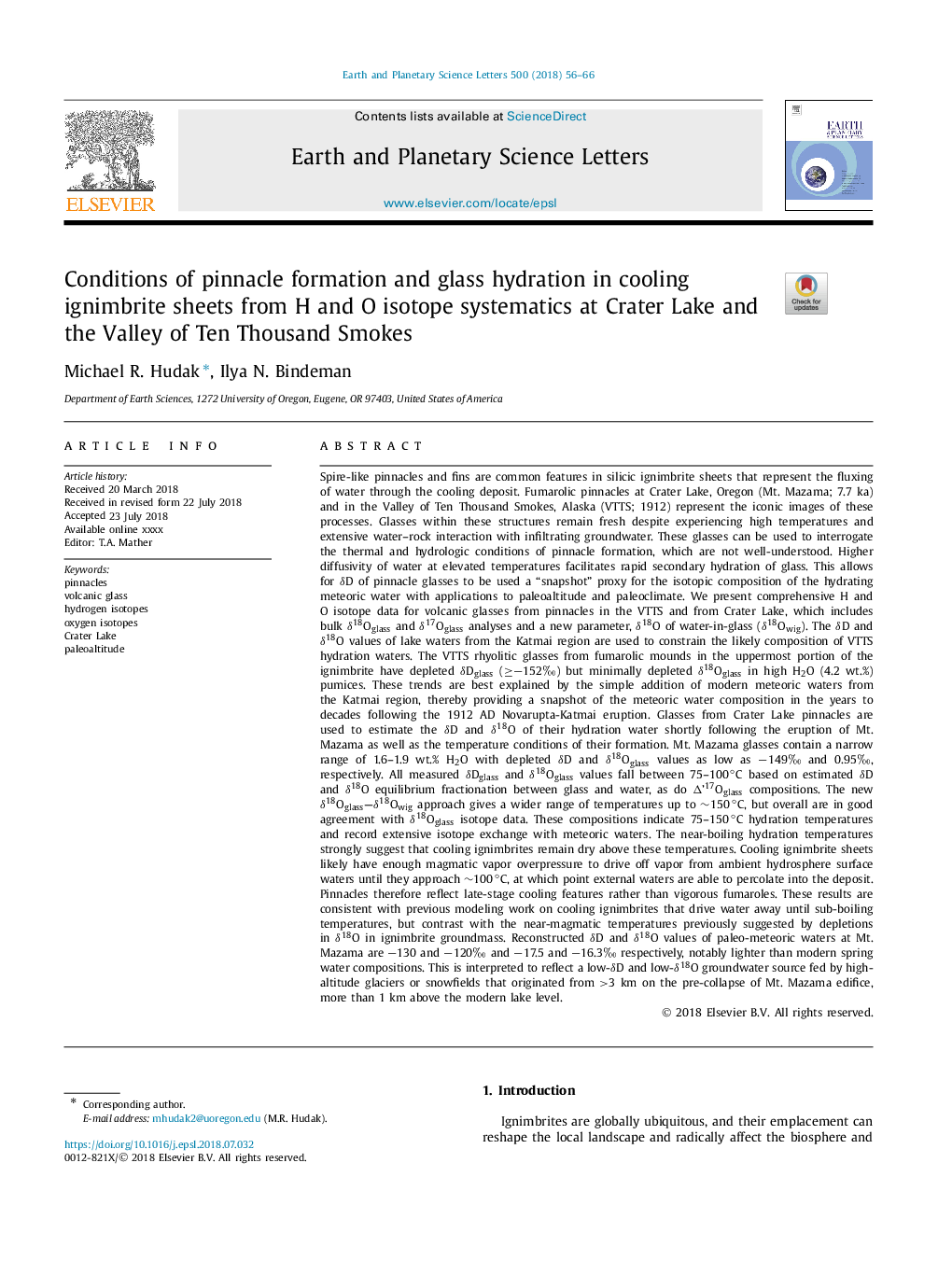| کد مقاله | کد نشریه | سال انتشار | مقاله انگلیسی | نسخه تمام متن |
|---|---|---|---|---|
| 8906654 | 1634656 | 2018 | 11 صفحه PDF | دانلود رایگان |
عنوان انگلیسی مقاله ISI
Conditions of pinnacle formation and glass hydration in cooling ignimbrite sheets from H and O isotope systematics at Crater Lake and the Valley of Ten Thousand Smokes
دانلود مقاله + سفارش ترجمه
دانلود مقاله ISI انگلیسی
رایگان برای ایرانیان
کلمات کلیدی
موضوعات مرتبط
مهندسی و علوم پایه
علوم زمین و سیارات
علوم زمین و سیاره ای (عمومی)
پیش نمایش صفحه اول مقاله

چکیده انگلیسی
Spire-like pinnacles and fins are common features in silicic ignimbrite sheets that represent the fluxing of water through the cooling deposit. Fumarolic pinnacles at Crater Lake, Oregon (Mt. Mazama; 7.7 ka) and in the Valley of Ten Thousand Smokes, Alaska (VTTS; 1912) represent the iconic images of these processes. Glasses within these structures remain fresh despite experiencing high temperatures and extensive water-rock interaction with infiltrating groundwater. These glasses can be used to interrogate the thermal and hydrologic conditions of pinnacle formation, which are not well-understood. Higher diffusivity of water at elevated temperatures facilitates rapid secondary hydration of glass. This allows for δD of pinnacle glasses to be used a “snapshot” proxy for the isotopic composition of the hydrating meteoric water with applications to paleoaltitude and paleoclimate. We present comprehensive H and O isotope data for volcanic glasses from pinnacles in the VTTS and from Crater Lake, which includes bulk δ18Oglass and δ17Oglass analyses and a new parameter, δ18O of water-in-glass (δ18Owig). The δD and δ18O values of lake waters from the Katmai region are used to constrain the likely composition of VTTS hydration waters. The VTTS rhyolitic glasses from fumarolic mounds in the uppermost portion of the ignimbrite have depleted δDglass (â¥â152â°) but minimally depleted δ18Oglass in high H2O (4.2 wt.%) pumices. These trends are best explained by the simple addition of modern meteoric waters from the Katmai region, thereby providing a snapshot of the meteoric water composition in the years to decades following the 1912 AD Novarupta-Katmai eruption. Glasses from Crater Lake pinnacles are used to estimate the δD and δ18O of their hydration water shortly following the eruption of Mt. Mazama as well as the temperature conditions of their formation. Mt. Mazama glasses contain a narrow range of 1.6-1.9 wt.% H2O with depleted δD and δ18Oglass values as low as â149â° and 0.95â°, respectively. All measured δDglass and δ18Oglass values fall between 75-100â°C based on estimated δD and δ18O equilibrium fractionation between glass and water, as do Î'17Oglass compositions. The new δ18Oglass-δ18Owig approach gives a wider range of temperatures up to â¼150â°C, but overall are in good agreement with δ18Oglass isotope data. These compositions indicate 75-150â°C hydration temperatures and record extensive isotope exchange with meteoric waters. The near-boiling hydration temperatures strongly suggest that cooling ignimbrites remain dry above these temperatures. Cooling ignimbrite sheets likely have enough magmatic vapor overpressure to drive off vapor from ambient hydrosphere surface waters until they approach â¼100â°C, at which point external waters are able to percolate into the deposit. Pinnacles therefore reflect late-stage cooling features rather than vigorous fumaroles. These results are consistent with previous modeling work on cooling ignimbrites that drive water away until sub-boiling temperatures, but contrast with the near-magmatic temperatures previously suggested by depletions in δ18O in ignimbrite groundmass. Reconstructed δD and δ18O values of paleo-meteoric waters at Mt. Mazama are â130 and â120â° and â17.5 and â16.3â° respectively, notably lighter than modern spring water compositions. This is interpreted to reflect a low-δD and low-δ18O groundwater source fed by high-altitude glaciers or snowfields that originated from >3 km on the pre-collapse of Mt. Mazama edifice, more than 1 km above the modern lake level.
ناشر
Database: Elsevier - ScienceDirect (ساینس دایرکت)
Journal: Earth and Planetary Science Letters - Volume 500, 15 October 2018, Pages 56-66
Journal: Earth and Planetary Science Letters - Volume 500, 15 October 2018, Pages 56-66
نویسندگان
Michael R. Hudak, Ilya N. Bindeman,